Title: Rio Sucasari Biotope
Post by: Ralph on February 28, 2003, 06:39:38 PM
| Rio Sucasari Biotope An Interview with Rhett A. Butler Taking us on another trip to the Peruvian Amazon, home of the peruvian greens, is Rhett A. Butler, author and world traveler. I first met Rhett through his website, Mongabay.com (https://www.mongabay.com/). It is a massive site packed with information (I'm still in the process of reading it). It is closely associated with his two books (A Place Out of Time: Tropical Rainforests and the Perils They Face and Tropical Freshwater Aquarium Fish). Half of the site is a general discussion of rainforests along with specifics on rainforests all over the world, including the Amazon. The other half of the site has information on tropical aquarium fish and aquarium care. It also includes my favorite part of the site (https://tropicalfreshwaterfish.com/biotope.htm) which provides detailed information on making biotope tanks that replicate waters from various parts of the world (there is a revised version of the biotope section coming in March). Rhett has traveled extensively and visited tropical forests all over to world to research his books. He has visited the Amazon River Basin in Brazil, Peru, and Ecuador and also the Orinoco in Venezuela. He has studied forests in Africa (including Madagascar), Southeast Asia, Australia, the Pacific Islands, Central America and Mexico, the Caribbean (or Caribbean), and numerous other places. Rhett is a graduate of the University of California at San Diego with a degree in Economics/Management Science. 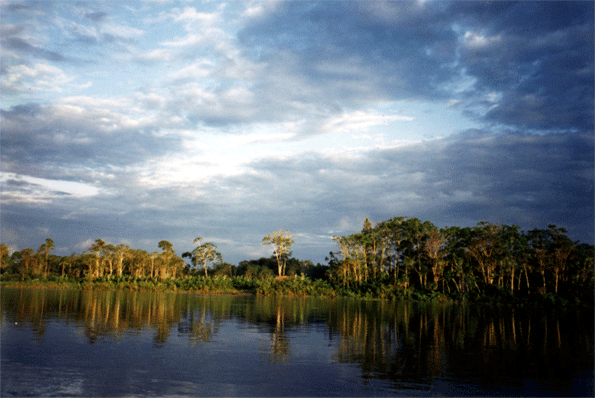 Rio Napo Where is the Rio Sucasari? The Rio Sucasari is a small tributary near the confluence of the Rio Napo and the Amazon River about 5 hours down river from Iquitos, Peru. It is an interesting area because of the diversity of habitats: the Rio Napo and Amazon are large whitewater rivers, while the Sucasari is a pure blackwater creek. There are also several Oxbow lakes, both whitewater and blackwater. I will specifically be describing a small creek off the Sucasari, which was under a nearly complete canopy shading. 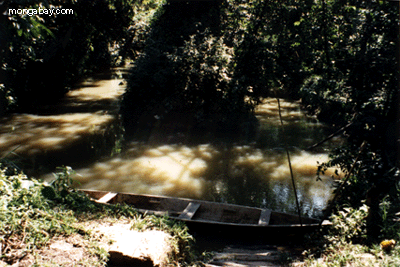 Sucasari creek What time of the year did you go there? I was there in the mid water season -- not low, not high. Water levels would fall lower and rise considerably higher (i.e. 20 feet). It was in August, 1995. Was there a lot of driftwood in the river? In the Sucasari creek there were numerous downed trees. Submerged wood is generally very dark in color. There were few living roots, but fallen tree matter (trees, branches) was much more common in this specific biotope. What other types of fish did you see living in that area? I only did a limited amount of collecting in the creek using dip nets, throw nets, and traditional fishing line. I snorkeled around a bit during the day and at night examined the creek using a floodlight. Pimelodids and Loricarids were abundant as were silver hatchetfish, Severum, and assorted small tetras in large schools (Hemigrammus, Hyphessobrycon, Boehlkea, and Thayeria). There were Apistogramma spp. and Brochis splendens among the leaf litter. I did not encounter any discus in that specific area. Did you see other animals and insects in that area? In the forest around the creek there were a large number of frogs, toads, and snakes. I found mata mata turtles in the shallows of the creek under fallen logs. As for aquatic insects, I saw few "swimmers" but many insect larvae living among the wood matter and rotting vegetation. There were land snails, but I failed to notice any aquatic snails. There were lots of flying insects especially flies and gnats but not too many mosquitoes. In the vegetation along the river there were many highly camouflaged katydids, grasshoppers, and other insects. Were people living in the area? The Maijuna tribe lives in a village consisting of around a hundred people who trade and fish in the river. As far as I know they do not collect fish for the aquarium trade. Because of the presence of the village, few day-active large mammals were present. The most abundant large mammal was the sloth. 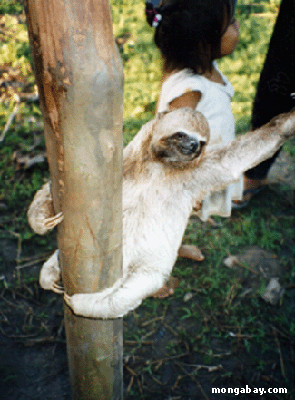 A pet Sloth What did the stream water look like? The creek was surprisingly deep given its width. Forest creeks in this region are often U-shaped, dropping off very quickly from the river bank due to the consistency of the clay substrate. Generally the blackwater creek was coffee-colored and fairly clear (at least 5 foot visibility) but after rains it resembled a white water creek (the pictures were taken after a morning rain). It would take about a day for the natural color/clarity to be restored. The pH was 5.9 with 0 measurable hardness. The water temperature varied between 82 and 84F. There was very little current. 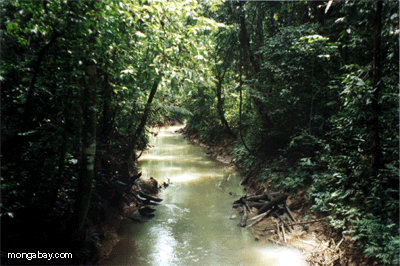 Sucasari creek after a rain Did you see aquatic plants in that area? There really weren't too many aquatic plants -- mostly roots and submerged wood. Water levels were at their midpoint, so many semi-aquatic plants that grew along the water are probably submerged at some point during the year. In some areas there were reedy plants growing fully submerged. In this particular area there were no floating plants but in adjacent oxbow lakes they were water lilies, water cabbage, and duckweed-like plants. Sword plants were also present in nearby swampy areas -- these grew both emerged and submerged. 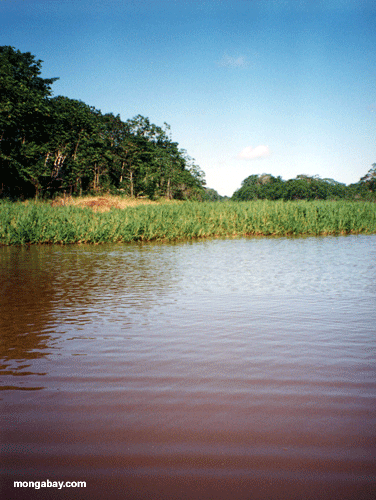 Oxbow lake Is algae commonly found in that area? There was algae growing on submerged wood but I didn't really take much note of it's characteristics. Submerged wood was generally slimy with algae and other unidentified matter. What did the river bed look like? No rocks whatsoever!! In this part of the Amazon, rocks are treated as a commodity and are used for trading because of their rarity. The river bed is orange/pinkish colored clay with several inches of rotting leaf litter and debris. The leaves had sharply pointed tips consistent with typical rainforest leaf shape (the so-called "drip-tips" facilitate water flow off the leaf surface). 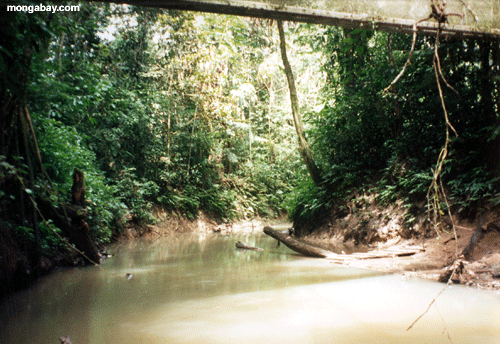 Sucasari creek I'd like to close with a quote out of Rhett's book, A Place Out of Time, that I really liked: Lingering beside a small stream in the Malaysian rainforest of Sabah, on the island of Borneo, I watch the water move swiftly over worn, round stones. The pace of the flow quickens as the stream cascades over a short falls into a clear pool. Vibrantly colored butterflies in shades of yellow, orange, and green flirt with columns of light that penetrates the dense canopy. The raucous calls of hornbills challenge the melodic drone of cicadas. Though the forest is never silent or still it brings a deep sense of calm. I sit with my feet in the cool water, picking over my clothes in search of leaf leaches, who seek a feeding opportunity in every crease of material. As I remove these brightly hued creatures, I am content to watch a lone male orangutan silently make his way through the branches above the stream. The idyllic setting and the company of my red bearded simian companion provide the perfect end to my half day trek. Such wildlands provide me with a mental and emotional escape from the daily rigors and chaos of the financial market and I have come to greatly appreciate places of natural wonder. - - - I have long had a fascination with the natural world and its creatures but the idea for this book arose out of deep sadness. Eight weeks after leaving that tract of Malaysian rainforest that had filled me with happiness, I learned the forest was gone. Logged for wood chips to supply a paper pulp plant, this place of natural wonder and beauty was lost forever. The orangutan, the hornbills, the butterflies, and even the leaches would now have to make do in their now dramatically changed environment. Despite my few years in the forest, this was not the first time I had lost such a special place, nor will it be the last. These personal losses have long troubled me, but the loss of that small section of forest in Borneo created the urgency to act upon a thought that had been nagging me. While environmental losses and degradation of the rainforests have yet to reach the point of collapse, the continuing disappearance of wildlands and loss of its species is disheartening. I feel sorrow for those who have yet had the privilege to experience the magnificence of these places and try to picture how - should biodiversity losses continue to mount - I will explain to my grandchildren why these places of natural wonder that I enjoyed in my youth no longer exist. The lesson of A Place Out of Time is we may not have to accept this future. A lot can still be done. Using our intelligence and ingenuity, the human species can preserve biodiversity and unique places for future generations, without compromising the quality of life for present populations. The photos and quote are copyright material and cannot be used without permission of Rhett A. Butler. I would like to thank Rhett for taking the time out of his busy schedule to do this interview, I appreciate it. I also want to thank Al, Ryan, and Dan for their help. |
Title: Re:Rio Sucasari Biotope
Post by: dm on February 28, 2003, 07:09:02 PM
| That was a great interview. Thanks Rhett and Ralph for taking the time to do it. |
Title: Re:Rio Sucasari Biotope
Post by: Carol_Roberts on February 28, 2003, 09:09:07 PM
| Thanks for the article and pictures! It's hard to imagine an area so devoid of rocks they are used as a commodity. |
Title: Re:Rio Sucasari Biotope
Post by: steelhead on February 28, 2003, 09:44:30 PM
| Excellent!! :thumbsup: :thumbsup: Thanks much! |
Title: Re:Rio Sucasari Biotope
Post by: thebaglady on February 28, 2003, 10:43:29 PM
| Enjoyed the interview very much. Even the somewhat somber closing which makes me think.. The demand for wood/paper by the industrialized nations is huge. We cannot condemn the companies that are committing rape on the rainforest for wanting to provide us with what we want, but we can re-evaluate our wants from our needs. Not to get on a soap box here but, at our business' and homes, everyone should be mindful of what they use, how much they use, if there's another way etc... And teach your kids and co-workers to conserve too. At the very least, talk about it. Don't ignore wasteful behavior. Do you know where your hardwoods came from that make up your dining room set? (I don't either) but what if we were all asking....wouldn't it put at least some pressure on the manufacturers to find out if it was coming from a sustainable forest where proper harvesting was not gonna decimate the entire area. As far as fish and rewarding the collector who doesn't overharvest, there's Project Piaba...someone else probably knows way more about this than I do. Jump right in...... |
Title: Re:Rio Sucasari Biotope
Post by: Francisco_Borrero on February 28, 2003, 11:15:47 PM
| Excellent snapshop for us who may never get there !!! Thanks so much Rhett for agreeing to do it, and Ralph for the initiative. This is excellent stuff. The somber part of it comes to me everytime I reflect back on my own country and the places I grew up in. Things are to get a lot worse in Colombia before they get better. Nature and wildlife suffer in between, and they hardly come back. There is very little that is really sustainable. Thanks again. Francisco. |
Title: Re:Rio Sucasari Biotope
Post by: April on March 02, 2003, 03:12:17 AM
| heres a link about project piaba. our aquarium club puts money from our auctions etc toward it in Vancouver. https://www.finarama.com/tba/projectpiaba/ great interview Ralph and Rhett. thanks. |
Title: Re:Rio Sucasari Biotope
Post by: thebaglady on March 02, 2003, 10:34:10 AM
| I applaud your club. You must have a very forward thinking, caring BOD. And thank you for the PP link. I think I'll order their $40 book. :) We have been chatting about this in "Are you talking to me? Germans smuggling...." section. The whole area celebrates their fish population every Feb. but this year, things went real sour for these German guys. I hope the fund benefits from their stiff fines. |
Title: Re:Rio Sucasari Biotope
Post by: Sparrow on March 02, 2003, 05:00:33 PM
| Wow. Great Interview! Project Piaba looks very worthwhile. I was poking around Rhett's site and found a couple of other pages that mention the conservation role of fish keepers. I think they are worth a look: https://tropicalfreshwaterfish.com/aquariast_role_conservation.htm https://tropicalfreshwaterfish.com/preface.htm I also liked his conclusion: https://www.mongabay.com/1026.htm |
Title: Re:Rio Sucasari Biotope
Post by: Ralph on March 02, 2003, 05:58:33 PM
| I was in doubt about including the environmental aspects in the interview, it wasn't something the Rhett suggested. It can be overdone sometimes and it's a little like preaching to the choir, but Rhett was so well-spoken on the subject and has such a common sense approach , it seemed appropriate to include it. Thanks for the Project Piaba link, April. Welcome to Simply, Sparrow. Monga.bay is on my favorites list, it is loaded with great articles, thanks for the links. |
Title: Re:Rio Sucasari Biotope
Post by: Debbie on March 02, 2003, 06:28:38 PM
| Thank you Ralph for another excellent interview. The environmental aspect did not come off as preaching, and I think your judgement was right on the mark. We need a reminder to conserve what resources we have. Thank you Rhett for taking the time for the interview. Your description of the rainforest was so vivid I felt like I was there. It's too bad I can never be there now. |
© 2001-2002, YaBB SE Dev Team. All Rights Reserved.